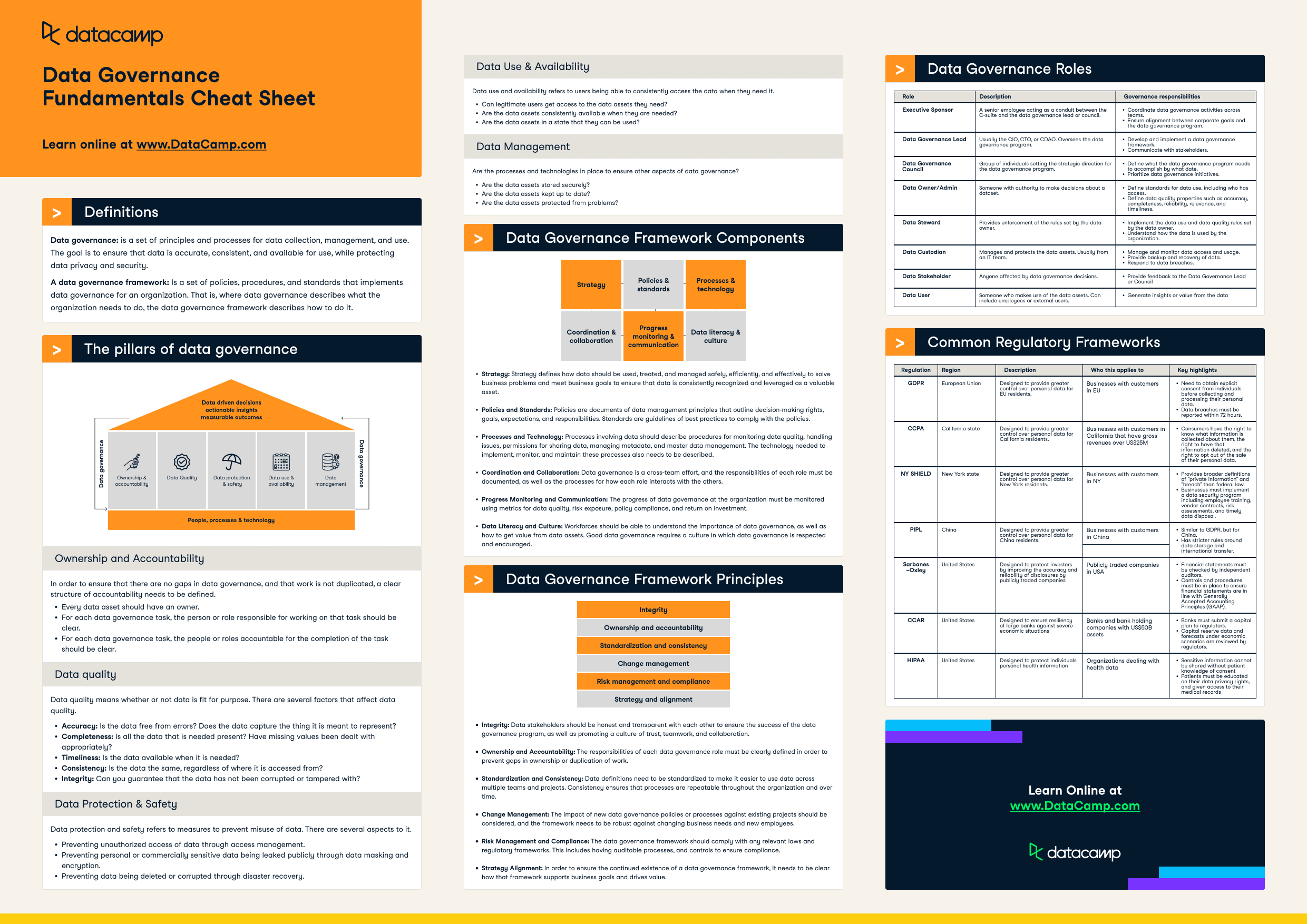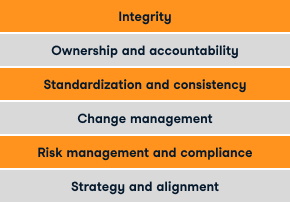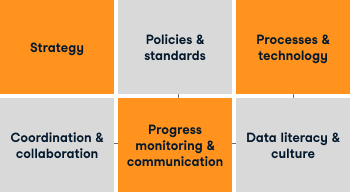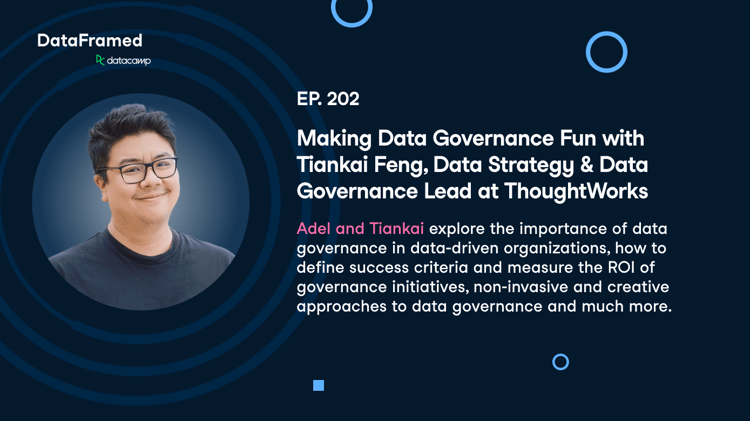Welcome to our Data Governance Fundamentals Cheat Sheet. This guide is designed to provide a quick reference for the essential concepts and best practices in data governance. Whether you're a data professional looking to improve your organization's data governance program or a student studying data governance, this cheat sheet will be a valuable resource. It covers key topics such as data governance objectives, key components of data governance program, data governance policies and procedures, data quality management and more. Keep it handy as you work through data governance projects or study for exams.

Have this cheat sheet at your fingertips
Download PDFDefinitions
Data governance is a set of principles and processes for data collection, management, and use. The goal is to ensure that data is accurate, consistent, and available for use while protecting data privacy and security.
A data governance framework is a set of policies, procedures, and standards that implements data governance for an organization. That is, where data governance describes what the organization needs to do, the data governance framework describes how to do it.
The pillars of data governance
Ownership and Accountability
To ensure that there are no gaps in data governance and that work is not duplicated, a clear structure of accountability needs to be defined.
- Every data asset should have an owner.
- For each data governance task, the person or role responsible for working on that task should be clear.
- For each data governance task, the people or roles accountable for the completion of the task should be clear.
Data Quality
Data quality means whether or not data is fit for purpose. There are several factors that affect data quality.
- Accuracy: Is the data free from errors? Does the data capture the thing it is meant to represent?
- Completeness: Is all the data that is needed present? Have missing values been dealt with appropriately?
- Timeliness: Is the data available when it is needed?
- Consistency: Is the data the same, regardless of where it is accessed from?
- Integrity: Can you guarantee that the data has not been corrupted or tampered with?
Data Protection & Safety
Data protection and safety refers to measures to prevent the misuse of data. There are several aspects to it.
- Preventing unauthorized access of data through access management.
- Preventing personal or commercially sensitive data being leaked publicly through data masking and encryption.
- Preventing data being deleted or corrupted through disaster recovery.
Data Use & Availability
Data use and availability refers to users being able to access the data when they need it consistently.
- Can legitimate users get access to the data assets they need?
- Are the data assets consistently available when they are needed?
- Are the data assets in a state that they can be used?
Data Management
Are the processes and technologies in place to ensure other aspects of data governance?
- Are the data assets stored securely?
- Are the data assets kept up to date?
- Are the data assets protected from problems?
Data Governance Framework Components
- Strategy: Strategy defines how data should be used, treated, and managed safely, efficiently, and effectively to solve business problems and meet business goals to ensure that data is consistently recognized and leveraged as a valuable asset.
- Policies and Standards: Policies are documents of data management principles that outline decision-making rights, goals, expectations, and responsibilities. Standards are guidelines of best practices to comply with the policies.
- Processes and Technology: Processes involving data should describe procedures for monitoring data quality, handling issues, permissions for sharing data, managing metadata, and master data management. The technology needed to implement, monitor, and maintain these processes must also be described.
- Coordination and Collaboration: Data governance is a cross-team effort, and the responsibilities of each role must be documented, as well as the processes for how each role interacts with the others.
- Progress Monitoring and Communication: The progress of data governance at the organization must be monitored using metrics for data quality, risk exposure, policy compliance, and return on investment.
- Data Literacy and Culture: Workforces should be able to understand the importance of data governance, as well as how to get value from data assets. Good data governance requires a culture in which data governance is respected and encouraged.
Data Governance Framework Principles

- Integrity: Data stakeholders should be honest and transparent with each other to ensure the success of the data governance program, as well as promoting a culture of trust, teamwork, and collaboration.
- Ownership and Accountability: The responsibilities of each data governance role must be clearly defined in order to prevent gaps in ownership or duplication of work.
- Standardization and Consistency: Data definitions need to be standardized to make it easier to use data across multiple teams and projects. Consistency ensures that processes are repeatable throughout the organization and over time.
- Change Management: The impact of new data governance policies or processes against existing projects should be considered, and the framework needs to be robust against changing business needs and new employees.
- Risk Management and Compliance: The data governance framework should comply with any relevant laws and regulatory frameworks. This includes having auditable processes, and controls to ensure compliance.
- Strategy Alignment: In order to ensure the continued existence of a data governance framework, it needs to be clear how that framework supports business goals and drives value.
Data Governance Roles
|
Role |
Description |
Governance responsibilities |
|
Executive Sponsor |
A senior employee acting as a conduit between the C-suite and the data governance lead or council. |
|
|
Data Governance Lead |
Usually the CIO, CTO, or CDAO. Oversees the data governance program. |
|
|
Data Governance Council |
Group of individuals setting the strategic direction for the data governance program. |
|
|
Data Owner/Admin |
Someone with authority to make decisions about a dataset. |
|
|
Data Steward |
Provides enforcement of the rules set by the data owner. |
|
|
Data Custodian |
Manages and protects the data assets. Usually from an IT team. |
|
|
Data Stakeholder |
Anyone affected by data governance decisions. |
|
|
Data User |
Someone who makes use of the data assets. Can include employees or external users. |
|
Common Regulatory Frameworks
|
Regulation |
Region |
Description |
Who this applies to |
Key highlights |
|
GDPR |
European Union |
Designed to provide greater control over personal data for EU residents. |
Businesses with customers in EU |
|
|
CCPA |
California state |
Designed to provide greater control over personal data for California residents. |
Businesses with customers in California that have gross revenues over US$25M |
|
|
NY SHIELD |
New York state |
Designed to provide greater control over personal data for New York residents. |
Businesses with customers in NY |
|
|
PIPL |
China |
Designed to provide greater control over personal data for China residents. |
Businesses with customers in China |
|
|
Sarbanes–Oxley |
United States |
Designed to protect investors by improving the accuracy and reliability of disclosures by publicly traded companies |
Publicly traded companies in USA |
|
|
CCAR |
United States |
Designed to ensure resiliency of large banks against severe economic situations |
Banks and bank holding companies with US$50B assets |
|
|
HIPAA |
United States |
Designed to protect individuals personal health information |
Organizations dealing with health data |
|




